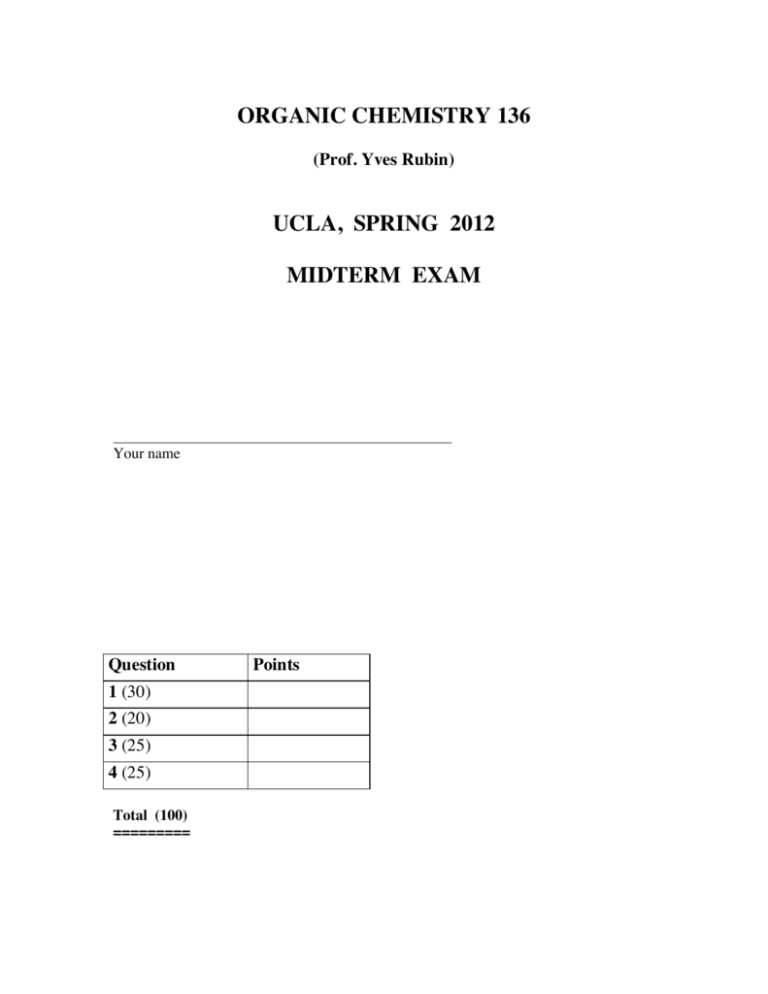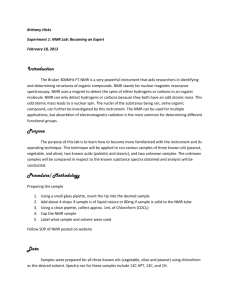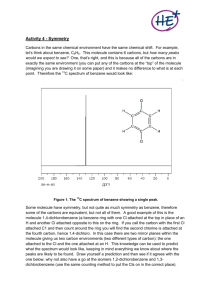CHEM 136-S12 Midterm - Research website of Prof. Yves Rubin
advertisement

ORGANIC CHEMISTRY 136 (Prof. Yves Rubin) UCLA, SPRING 2012 MIDTERM EXAM Your name Question 1 (30) 2 (20) 3 (25) 4 (25) Total (100) ========= Points Organic Chemistry 136 Spring 2012 MIDTERM EXAM, Page 1 Name 1. a) (10 points) Explain using only a few sentences and/or a diagram why the C–H stretching frequency of CHCl3 appears at 3000 cm–1, while the C–D stretching frequency for CDCl3 appears at 2260 cm–1. Organic Chemistry 136 Spring 2012 MIDTERM EXAM, Page 2 Name Question 1 continued: b) (5 points) What are the absorption bands at 1205 and 907 cm–1 in the IR spectra of CHCl3 and CDCl3, respectively? c) (10 points) Explain the doubled peak at 1775 and 1733 cm–1 in the following IR spectrum. Also, what vibration does the associated fundamental frequency correspond to? d) (5 points) Explain the absorption peak at 3470 cm–1 in the IR spectrum above: Organic Chemistry 136 Spring 2012 MIDTERM EXAM, Page 3 Name 2. a) (10 points) A compound contains 4 carbons and displays only 1 sharp singlet in its 1H NMR spectrum along with one broad singlet. Using its IR spectra recorded in two different media (neat film or dilute CCl4 solution), assign recognizable absorptions in both spectra, labeling clearly what type they are, and provide the structure that fits these data: (liquid film) (dilute CCl4 solution) b) (10 points) Draw theoretical 1H NMR coupling patterns (i.e. the way splittings would appear in a 1H NMR spectrum) for the H’s highlighted in boldface in the following two compounds. Also label the pattern (e.g. t, dd): H Cl H O Cl O H O H CH2Cl Organic Chemistry 136 Spring 2012 MIDTERM EXAM, Page 4 Name 3. a) (25 points) In addition to carbon and hydrogen atoms, the exact number of which you can determine from the 1H and 13C NMR spectra provided below, the following compound contains only two heteroatoms, 1 oxygen and 1 sulfur. Its IR spectrum is also provided to help you with structure determination. Assign recognizable IR absorptions, as well as all the signals of the 1H NMR spectrum (but not carbons in this problem). Then provide the structure of this compound and provide your reasoning: (liquid film) Structure: Reasoning on how you deduced your structure: Organic Chemistry 136 Spring 2012 MIDTERM EXAM, Page 5 Name Problem 3 continued… 1 H NMR spectrum, with 1:1:1:2:1 integral ratios from left-to-right. Coupling constants for peaks within the same sequence: 7.58 (J = 2.9, 0.9 Hz), 6.40 (J = 3.2, 2.9 Hz), 6.08 (J = 3.2, 0.9 Hz), 3.73 (J = 7.7 Hz), 1.90 (J = 7.7 Hz): 13 C NMR spectrum: Organic Chemistry 136 Spring 2012 MIDTERM EXAM, Page 6 Name 4. (25 points) A compound has the molecular formula C6H14O2. Deduce its structure from the IR, 1H NMR and 13C NMR spectra given below: Degree of unsaturation: IR spectrum (neat film): Explain your analysis of the data and deduction of the final structure here: Organic Chemistry 136 Spring 2012 MIDTERM EXAM, Page 7 Name 1H NMR spectrum for question 4: Please draw structure here as well, and provide assignments between protons on structure and relevant peaks using arrows pointing to the peaks in the spectrum: Expansion of spectrum from 3.2 – 3.9 ppm: 1H + 1H 1H Expansion of spectrum from 1.5 – 1.7 ppm: 1H 1H 6H 2H See integration above 1H Organic Chemistry 136 Spring 2012 MIDTERM EXAM, Page 8 Name 13C NMR spectrum for question 4: Please draw structure here again, and provide assignments for all carbons on the structure and relevant peaks using arrows or letters (note that carbons at 67 and 74 ppm can be assigned based on their degree of substitution).







